Recent Advances in Wearable Thermal Devices for Virtual and Augmented Reality
Abstract
1. Introduction
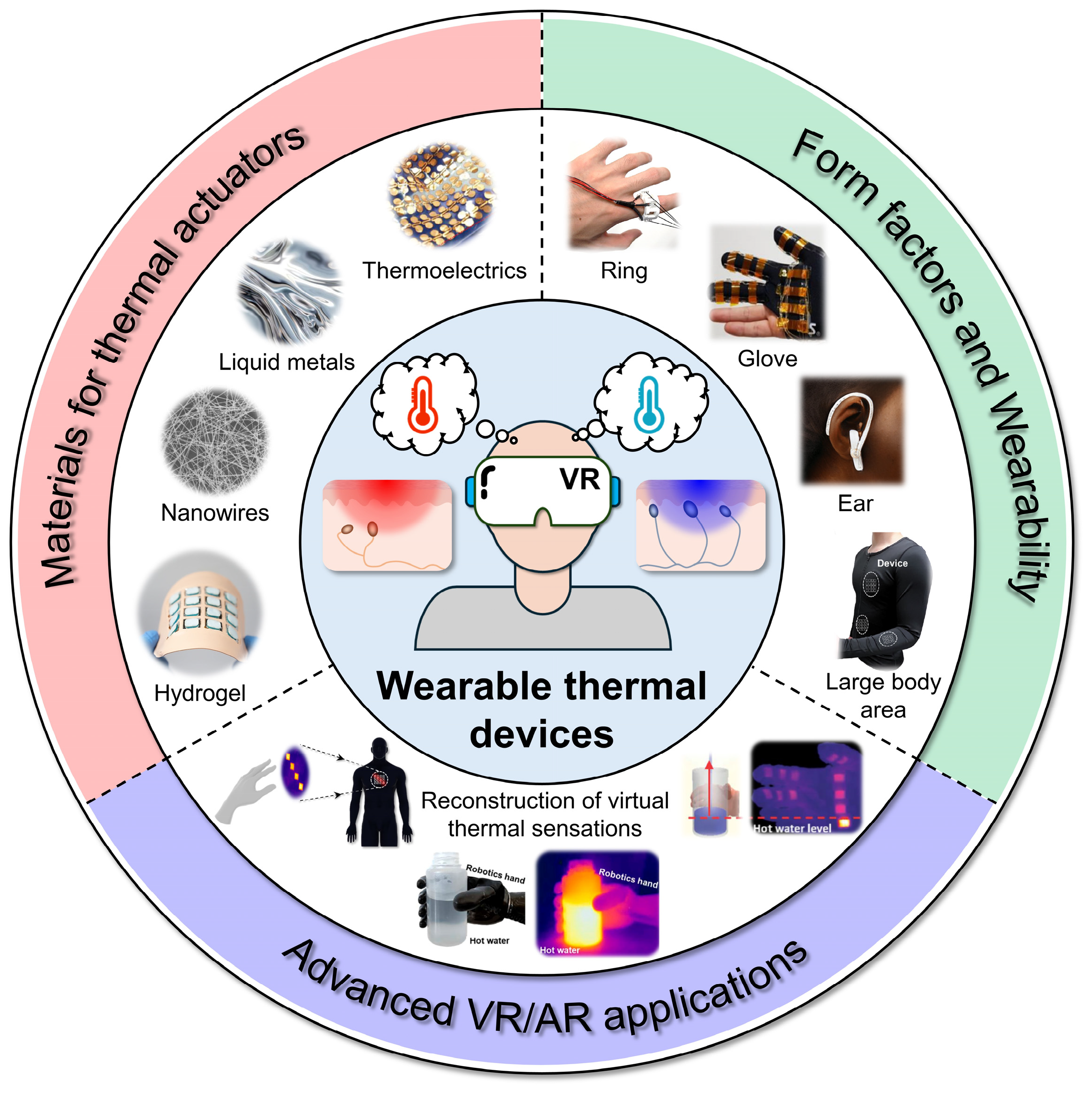
2. Thermal Stimulation and Perception in the Skin
3. Wearable Thermal Devices (WTDs)
3.1. Resistive Heating
3.1.1. Silver Nanowires (Ag NWs)
3.1.2. Copper Nanowires (Cu NWs)
3.1.3. Carbon Nanotubes (CNTs)
3.1.4. Liquid Metals (LMs)
3.2. Thermoelectrics
3.3. Integrating Passive Cooling Mechanism
4. Form Factors and Wearability of WTDs
5. Applications of WTDs in Virtual and Augmented Reality
6. Conclusions and Future Outlook
Funding
Conflicts of Interest
References
- Burdea, G. Virtual Reality Technology; John Wiley & Sons: Hoboken, NJ, USA, 2003. [Google Scholar]
- Svidt, K.; Sørensen, J.B. Development of a Virtual Reality Solution for End User Involvement in Interior Design. In Proceedings of the ECAADe 2016, Oulu School of Architecture, Oulu, Finland, 22–26 August 2016; pp. 541–546. [Google Scholar]
- Gharat, S.S. Vibro-Thermal Haptic Display for Socio-Emotional Communication Through Pattern Generations. Master’s Thesis, Arizona State University, Tempe, AZ, USA, April 2021. [Google Scholar]
- Rauschnabel, P.A.; Rossmann, A.; tom Dieck, M.C. An adoption framework for mobile augmented reality games: The case of Pokémon Go. Comput. Hum. Behav. 2017, 76, 276–286. [Google Scholar]
- Von Itzstein, G.S.; Billinghurst, M.; Smith, R.T.; Thomas, B.H. Augmented reality entertainment: Taking gaming out of the box. In Encyclopedia of Computer Graphics and Games; Springer: Berlin/Heidelberg, Germany, 2024; pp. 162–170. [Google Scholar]
- Lyu, M.R.; King, I.; Wong, T.; Yau, E.; Chan, P. Arcade: Augmented reality computing arena for digital entertainment. In Proceedings of the 2005 IEEE Aerospace Conference, Big Sky, MT, USA, 5–12 March 2005; pp. 1–9. [Google Scholar]
- Zhu, E.; Hadadgar, A.; Masiello, I.; Zary, N. Augmented reality in healthcare education: An integrative review. PeerJ 2014, 2, e469. [Google Scholar]
- Carruth, D.W. Virtual reality for education and workforce training. In Proceedings of the 2017 15th International Conference on Emerging eLearning Technologies and Applications (ICETA), Stary Smokovec, Slovakia, 26–27 October 2017; pp. 1–6. [Google Scholar]
- Bhugaonkar, K.; Bhugaonkar, R.; Masne, N. The trend of metaverse and augmented & virtual reality extending to the healthcare system. Cureus 2022, 14, e29071. [Google Scholar] [PubMed]
- Ara, J.; Karim, F.B.; Alsubaie, M.S.A.; Bhuiyan, Y.A.; Bhuiyan, M.I.; Bhyan, S.B.; Bhuiyan, H. Comprehensive analysis of augmented reality technology in modern healthcare system. Int. J. Adv. Comput. Sci. Appl. 2021, 12, 840–849. [Google Scholar] [CrossRef]
- Kaplan, A.D.; Cruit, J.; Endsley, M.; Beers, S.M.; Sawyer, B.D.; Hancock, P.A. The effects of virtual reality, augmented reality, and mixed reality as training enhancement methods: A meta-analysis. Hum. Factors 2021, 63, 706–726. [Google Scholar]
- Gavish, N.; Gutiérrez, T.; Webel, S.; Rodríguez, J.; Peveri, M.; Bockholt, U.; Tecchia, F. Evaluating virtual reality and augmented reality training for industrial maintenance and assembly tasks. Interact. Learn. Environ. 2015, 23, 778–798. [Google Scholar] [CrossRef]
- Lee, K. The Future of Learning and Training in Augmented Reality. In InSight: A Journal of Scholarly Teaching; Mandernach, B.J., Ockerstrom, L.J., Eds.; Park University: Parkville, MO, USA, 2012; Volume 7, pp. 31–42. [Google Scholar]
- Yu, X.; Xie, Z.; Yu, Y.; Lee, J.; Vazquez-Guardado, A.; Luan, H.; Ruban, J.; Ning, X.; Akhtar, A.; Li, D.; et al. Skin-integrated wireless haptic interfaces for virtual and augmented reality. Nature 2019, 575, 473–479. [Google Scholar]
- Flavin, M.T.; Ha, K.-H.; Guo, Z.; Li, S.; Kim, J.-T.; Saxena, T.; Simatos, D.; Al-Najjar, F.; Mao, Y.; Bandapalli, S.; et al. Bioelastic state recovery for haptic sensory substitution. Nature 2024, 635, 345–352. [Google Scholar] [CrossRef]
- Jung, Y.H.; Yoo, J.-Y.; Vázquez-Guardado, A.; Kim, J.-H.; Kim, J.-T.; Luan, H.; Park, M.; Lim, J.; Shin, H.-S.; Su, C.-J.; et al. A wireless haptic interface for programmable patterns of touch across large areas of the skin. Nat. Electron. 2022, 5, 374–385. [Google Scholar]
- Liu, Y.; Yiu, C.K.; Zhao, Z.; Liu, S.; Huang, X.; Park, W.; Su, J.; Zhou, J.; Wong, T.H.; Yao, K.; et al. Skin-Integrated Haptic Interfaces Enabled by Scalable Mechanical Actuators for Virtual Reality. IEEE Internet Things J. 2022, 10, 653–663. [Google Scholar] [CrossRef]
- Li, J.; Fu, Y.; Zhou, J.; Yao, K.; Ma, X.; Gao, S.; Wang, Z.; Dai, J.-G.; Lei, D.; Yu, X. Ultrathin, soft, radiative cooling interfaces for advanced thermal management in skin electronics. Sci. Adv. 2023, 9, eadg1837. [Google Scholar] [PubMed]
- Park, M.; Yoo, J.-Y.; Yang, T.; Jung, Y.H.; Vázquez-Guardado, A.; Li, S.; Kim, J.-H.; Shin, J.; Maeng, W.-Y.; Lee, G.; et al. Skin-integrated systems for power efficient, programmable thermal sensations across large body areas. Proc. Natl. Acad. Sci. USA 2023, 120, e2217828120. [Google Scholar]
- Kim, J.-H.; Vázquez-Guardado, A.; Luan, H.; Kim, J.-T.; Yang, D.S.; Zhang, H.; Chang, J.-K.; Yoo, S.; Park, C.; Wei, Y.; et al. A wirelessly programmable, skin-integrated thermo-haptic stimulator system for virtual reality. Proc. Natl. Acad. Sci. USA 2024, 121, e2404007121. [Google Scholar]
- Zhu, K.; Perrault, S.; Chen, T.; Cai, S.; Lalintha Peiris, R. A sense of ice and fire: Exploring thermal feedback with multiple thermoelectric-cooling elements on a smart ring. Int. J. Hum. Comput. Stud. 2019, 130, 234–247. [Google Scholar]
- Song, S.; Noh, G.; Yoo, J.; Oakley, I.; Cho, J.; Bianchi, A. Hot & tight: Exploring thermo and squeeze cues recognition on wrist wearables. In Proceedings of the 2015 ACM International Symposium on Wearable Computers, Osaka, Japan, 7–11 September 2015; pp. 39–42. [Google Scholar]
- Liu, Y.; Nishikawa, S.; Seong, Y.A.; Niiyama, R.; Kuniyoshi, Y. ThermoCaress: A Wearable Haptic Device with Illusory Moving Thermal Stimulation. In Proceedings of the 2021 CHI Conference on Human Factors in Computing Systems, Yokohama, Japan, 8–13 May 2021; pp. 1–12. [Google Scholar]
- Maeda, T.; Kurahashi, T. TherModule: Wearable and Modular Thermal Feedback System based on a Wireless Platform. In Proceedings of the 10th Augmented Human International Conference 2019, Reims, France, 11–12 March 2019; pp. 1–8. [Google Scholar]
- Peiris, R.L.; Feng, Y.-L.; Chan, L.; Minamizawa, K. ThermalBracelet: Exploring Thermal Haptic Feedback Around the Wrist. In Proceedings of the 2019 CHI Conference on Human Factors in Computing Systems, Glasgow, UK, 4–9 May 2019; pp. 1–11. [Google Scholar]
- Kim, S.-W.; Kim, S.H.; Kim, C.S.; Yi, K.; Kim, J.-S.; Cho, B.J.; Cha, Y. Thermal display glove for interacting with virtual reality. Sci. Rep. 2020, 10, 11403. [Google Scholar]
- Cai, S.; Ke, P.; Narumi, T.; Zhu, K. ThermAirGlove: A Pneumatic Glove for Thermal Perception and Material Identification in Virtual Reality. In Proceedings of the 2020 IEEE Conference on Virtual Reality and 3D User Interfaces (VR), Atlanta, GA, USA. 22–26 March 2020; pp. 248–257. [Google Scholar]
- Nasser, A.; Zheng, K.; Zhu, K. ThermEarhook: Investigating Spatial Thermal Haptic Feedback on the Auricular Skin Area. In Proceedings of the 2021 International Conference on Multimodal Interaction, Montréal, QC, Canada, 18–22 October 2021; pp. 662–672. [Google Scholar]
- Lee, J.; Sul, H.; Lee, W.; Pyun, K.R.; Ha, I.; Kim, D.; Park, H.; Eom, H.; Yoon, Y.; Jung, J.; et al. Stretchable Skin-Like Cooling/Heating Device for Reconstruction of Artificial Thermal Sensation in Virtual Reality. Adv. Funct. Mater. 2020, 30, 1909171. [Google Scholar]
- Hong, S.; Gu, Y.; Seo, J.K.; Wang, J.; Liu, P.; Meng, Y.S.; Xu, S.; Chen, R. Wearable thermoelectrics for personalized thermoregulation. Sci. Adv. 2019, 5, eaaw0536. [Google Scholar] [PubMed]
- Kim, D.; Bang, J.; Lee, W.; Ha, I.; Lee, J.; Eom, H.; Kim, M.; Park, J.; Choi, J.; Kwon, J.; et al. Highly stretchable and oxidation-resistive Cu nanowire heater for replication of the feeling of heat in a virtual world. J. Mater. Chem. A 2020, 8, 8281–8291. [Google Scholar]
- Luo, M.; Wang, Z.; Zhang, H.; Arens, E.; Filingeri, D.; Jin, L.; Ghahramani, A.; Chen, W.; He, Y.; Si, B. High-density thermal sensitivity maps of the human body. Build. Environ. 2020, 167, 106435. [Google Scholar] [CrossRef]
- Jones, L.A.; Berris, M. The psychophysics of temperature perception and thermal-interface design. In Proceedings of the 10th Symposium on Haptic Interfaces for Virtual Environment and Teleoperator Systems HAPTICS 2002, Orlando, FL, USA, 24–25 March 2002; pp. 137–142. [Google Scholar]
- Cain, W.S. Spatial discrimination of cutaneous warmth. Am. J. Psychol. 1973, 86, 169–181. [Google Scholar]
- Weber, E.H. The sense of touch and common feeling, 1846. In Readings in the History of Psychology; Dennis, W., Ed.; Appleton-Century-Crofts: Norwalk, CT, USA, 1948. [Google Scholar]
- Hardy, J.D.; Oppel, T.W. Studies in temperature sensation. III. The sensitivity of the body to heat and the spatial summation of the end organ responses. J. Clin. Investig. 1937, 16, 533–540. [Google Scholar] [PubMed]
- Kenshalo, D.R.; Decker, T.; Hamilton, A. Spatial summation on the forehead, forearm, and back produced by radiant and conducted heat. J. Comp. Physiol. Psychol. 1967, 63, 510. [Google Scholar] [CrossRef]
- Choi, S.; Park, J.; Hyun, W.; Kim, J.; Kim, J.; Lee, Y.B.; Song, C.; Hwang, H.J.; Kim, J.H.; Hyeon, T.; et al. Stretchable heater using ligand-exchanged silver nanowire nanocomposite for wearable articular thermotherapy. ACS Nano 2015, 9, 6626–6633. [Google Scholar] [CrossRef] [PubMed]
- Parida, K.; Bark, H.; Lee, P.S. Emerging Thermal Technology Enabled Augmented Reality. Adv. Funct. Mater. 2021, 31, 2007952. [Google Scholar]
- Spray, D.C. Cutaneous temperature receptors. Annu. Rev. Physiol. 1986, 48, 625–638. [Google Scholar]
- Carslaw, H.; Jaeger, J. Conduction of Heat in Solids; Clarendon Press: Oxford, UK, 1959. [Google Scholar]
- Bergman, T.L. Fundamentals of Heat and Mass Transfer; John Wiley & Sons: Hoboken, NJ, USA, 2011. [Google Scholar]
- Yarnitsky, D.; Ochoa, J.L. Studies of heat pain sensation in man: Perception thresholds, rate of stimulus rise and reaction time. Pain 1990, 40, 85–91. [Google Scholar] [CrossRef]
- Iannetti, G.D.; Leandri, M.; Truini, A.; Zambreanu, L.; Cruccu, G.; Tracey, I. Aδ nociceptor response to laser stimuli: Selective effect of stimulus duration on skin temperature, brain potentials and pain perception. Clin. Neurophysiol. 2004, 115, 2629–2637. [Google Scholar] [PubMed]
- Hunter, J.; Dranga, R.; van Wyk, M.; Dostrovsky, J.O. Unique influence of stimulus duration and stimulation site (glabrous vs. hairy skin) on the thermal grill-induced percept. Eur. J. Pain 2015, 19, 202–215. [Google Scholar]
- Kim, D.; Zhu, L.; Jeong, D.-J.; Chun, K.; Bang, Y.-Y.; Kim, S.-R.; Kim, J.-H.; Oh, S.-K. Transparent flexible heater based on hybrid of carbon nanotubes and silver nanowires. Carbon 2013, 63, 530–536. [Google Scholar]
- Lee, Y.; Le, V.T.; Kim, J.G.; Kang, H.; Kim, E.S.; Ahn, S.E.; Suh, D. Versatile, High-Power, Flexible, Stretchable Carbon Nanotube Sheet Heating Elements Tolerant to Mechanical Damage and Severe Deformation. Adv. Funct. Mater. 2018, 28, 1706007. [Google Scholar]
- Zhang, M.; Wang, C.; Liang, X.; Yin, Z.; Xia, K.; Wang, H.; Jian, M.; Zhang, Y. Weft-knitted fabric for a highly stretchable and low-voltage wearable heater. Adv. Electron. Mater. 2017, 3, 1700193. [Google Scholar]
- Jang, N.-S.; Kim, K.-H.; Ha, S.-H.; Jung, S.-H.; Lee, H.M.; Kim, J.-M. Simple approach to high-performance stretchable heaters based on kirigami patterning of conductive paper for wearable thermotherapy applications. ACS Appl. Mater. Interfaces 2017, 9, 19612–19621. [Google Scholar] [CrossRef] [PubMed]
- Zhang, L.; Baima, M.; Andrew, T.L. Transforming commercial textiles and threads into sewable and weavable electric heaters. ACS Appl. Mater. Interfaces 2017, 9, 32299–32307. [Google Scholar] [PubMed]
- Hsu, P.-C.; Liu, X.; Liu, C.; Xie, X.; Lee, H.R.; Welch, A.J.; Zhao, T.; Cui, Y. Personal thermal management by metallic nanowire-coated textile. Nano Lett. 2015, 15, 365–371. [Google Scholar] [CrossRef]
- Hong, S.; Lee, H.; Lee, J.; Kwon, J.; Han, S.; Suh, Y.D.; Cho, H.; Shin, J.; Yeo, J.; Ko, S.H. Highly stretchable and transparent metal nanowire heater for wearable electronics applications. Adv. Mater. 2015, 27, 4744–4751. [Google Scholar] [CrossRef]
- Wang, Y.; Yu, Z.; Mao, G.; Liu, Y.; Liu, G.; Shang, J.; Qu, S.; Chen, Q.; Li, R.W. Printable liquid-metal@ PDMS stretchable heater with high stretchability and dynamic stability for wearable thermotherapy. Adv. Mater. Technol. 2019, 4, 1800435. [Google Scholar]
- Ji, S.; He, W.; Wang, K.; Ran, Y.; Ye, C. Thermal response of transparent silver nanowire/PEDOT: PSS film heaters. Small 2014, 10, 4951–4960. [Google Scholar] [CrossRef]
- Zhang, X.; Yan, X.; Chen, J.; Zhao, J. Large-size graphene microsheets as a protective layer for transparent conductive silver nanowire film heaters. Carbon 2014, 69, 437–443. [Google Scholar]
- Chen, J.; Chen, J.; Li, Y.; Zhou, W.; Feng, X.; Huang, Q.; Zheng, J.-G.; Liu, R.; Ma, Y.; Huang, W. Enhanced oxidation-resistant Cu–Ni core–shell nanowires: Controllable one-pot synthesis and solution processing to transparent flexible heaters. Nanoscale 2015, 7, 16874–16879. [Google Scholar] [CrossRef]
- Kim, T.; Kim, Y.W.; Lee, H.S.; Kim, H.; Yang, W.S.; Suh, K.S. Uniformly interconnected silver-nanowire networks for transparent film heaters. Adv. Funct. Mater. 2013, 23, 1250–1255. [Google Scholar] [CrossRef]
- Wang, R.; Xu, Z.; Zhuang, J.; Liu, Z.; Peng, L.; Li, Z.; Liu, Y.; Gao, W.; Gao, C. Highly Stretchable Graphene Fibers with Ultrafast Electrothermal Response for Low-Voltage Wearable Heaters. Adv. Electron. Mater. 2017, 3, 1. [Google Scholar] [CrossRef]
- Guo, R.; Sun, X.; Yao, S.; Duan, M.; Wang, H.; Liu, J.; Deng, Z. Semi-liquid-metal-(Ni-EGaIn)-based ultraconformable electronic tattoo. Adv. Mater. Technol. 2019, 4, 1900183. [Google Scholar]
- Li, Y.; Zhang, Z.; Li, X.; Zhang, J.; Lou, H.; Shi, X.; Cheng, X.; Peng, H. A smart, stretchable resistive heater textile. J. Mater. Chem. A 2017, 5, 41–46. [Google Scholar] [CrossRef]
- Pahalagedara, L.R.; Siriwardane, I.W.; Tissera, N.D.; Wijesena, R.N.; de Silva, K.N. Carbon black functionalized stretchable conductive fabrics for wearable heating applications. RSC Adv. 2017, 7, 19174–19180. [Google Scholar] [CrossRef]
- Cheng, Y.; Zhang, H.; Wang, R.; Wang, X.; Zhai, H.; Wang, T.; Jin, Q.; Sun, J. Highly stretchable and conductive copper nanowire based fibers with hierarchical structure for wearable heaters. ACS Appl. Mater. Interfaces 2016, 8, 32925–32933. [Google Scholar] [PubMed]
- Liu, P.; Li, Y.; Xu, Y.; Bao, L.; Wang, L.; Pan, J.; Zhang, Z.; Sun, X.; Peng, H. Stretchable and energy-efficient heating carbon nanotube fiber by designing a hierarchically helical structure. Small 2018, 14, 1702926. [Google Scholar]
- Jeong, S.; Oh, J.; Kim, H.; Bae, J.; Ko, S.H. Pattern design of a liquid metal-based wearable heater for constant heat generation under biaxial strain. iScience 2023, 26, 107008. [Google Scholar]
- Liu, J.; Zhang, L.; Zhao, H.; Zhang, Z. Highly transparent MXene/silver nanowire conductors for high-performance transparent heater. Opt. Mater. 2024, 153, 115575. [Google Scholar] [CrossRef]
- Cheng, R.; Wang, B.; Zeng, J.; Li, J.; Xu, J.; Gao, W.; Chen, K. High-performance and rapid-response electrical heaters derived from cellulose nanofiber/silver nanowire nanopapers for portable thermal management. ACS Appl. Mater. Interfaces 2022, 14, 30144–30159. [Google Scholar] [CrossRef]
- Kwon, M.; Kim, H.; Mohanty, A.K.; Yang, J.; Piao, L.; Joo, S.W.; Han, J.T.; Han, J.H.; Paik, H.j. Molecular-Level Contact of Graphene/Silver Nanowires through Simultaneous Dispersion for a Highly Stable Wearable Electrothermal Heater. Adv. Mater. Technol. 2021, 6, 2100177. [Google Scholar] [CrossRef]
- Sun, B.; Xu, R.; Han, X.; Xu, J.; Hong, W.; Xu, Y.; Fu, Z.; Zhu, H.; Sun, X.; Wang, J.; et al. Ultra-high temperature tolerant flexible transparent electrode with embedded silver nanowires bundle micromesh for electrical heater. npj Flexible Electron. 2022, 6, 48. [Google Scholar]
- Hua, L.; Song, L.; Chen, W.-J.; Huang, J.; Kou, Y.; Yu, S.; Yan, N.; Lu, Z. Multifunctional composite flexible films of hydroxypropyl cellulose and silver nanowires. Ind. Crops. Prod. 2024, 215, 118532. [Google Scholar] [CrossRef]
- Dimngaihvungi, E.; Changkakoty, P.; Singh, M.; Singh, A.K.; Pani, B.; Singh, A.K. Molybdenum oxide-covered silver nanowire films embedded in polyimide for application as high performance flexible transparent heater. Surf. Interfaces 2025, 56, 105582. [Google Scholar]
- Zou, X.; Zhao, M.; Shen, K.; Huang, C.; Wu, Y.; Fang, G. Cellulose wrapped silver nanowire film with enhanced stability for transparent wearable heating and electromagnetic interference shielding. J. Alloys Compd. 2022, 907, 164360. [Google Scholar]
- Wang, P.; Jian, M.; Wu, M.; Zhang, C.; Zhou, C.; Ling, X.; Zhang, J.; Yang, L. Highly sandwich-structured silver nanowire hybrid transparent conductive films for flexible transparent heater applications. Compos. A Appl. Sci. Manuf. 2022, 159, 106998. [Google Scholar]
- Yang, S.; Yan, D.-X.; Li, Y.; Lei, J.; Li, Z.-M. Flexible poly (vinylidene fluoride)-MXene/silver nanowire electromagnetic shielding films with joule heating performance. Ind. Eng. Chem. Res. 2021, 60, 9824–9832. [Google Scholar]
- Zeng, X.Y.; Zhang, Q.K.; Yu, R.M.; Lu, C.Z. A new transparent conductor: Silver nanowire film buried at the surface of a transparent polymer. Adv. Mater. 2010, 40, 4484–4488. [Google Scholar]
- Madaria, A.R.; Kumar, A.; Zhou, C. Large scale, highly conductive and patterned transparent films of silver nanowires on arbitrary substrates and their application in touch screens. Nanotechnology 2011, 22, 245201. [Google Scholar]
- Park, S.-R.; Park, S.-J.; Kim, J.; Ha, T.-J. Highly stable low-voltage operating mobile transparent heaters based on spray-coated MXene/silver nanowire nanocomposite electrodes powered by indoor solar cells. Appl. Surf. Sci. 2024, 674, 160929. [Google Scholar]
- Kong, X.; Chen, H.; Li, H.; Yue, L.; Gong, M.; Lin, X.; Zhang, M.; Zhang, L.; Wang, D. Hierarchically Ordered Grid-Type Silver Nanowire Microelectrodes via Direct Ink Writing. ACS Appl. Nano Mater. 2024, 7, 14898–14905. [Google Scholar]
- Jin, I.S.; Choi, J.; Jung, J.W. Silver-nanowire-embedded photopolymer films for transparent film heaters with ultra-flexibility, quick thermal response, and mechanical reliability. Adv. Electron. Mater. 2021, 7, 2000698. [Google Scholar] [CrossRef]
- Patil, P.; Patil, S.; Kate, P.; Kulkarni, A.A. Inkjet printing of silver nanowires on flexible surfaces and methodologies to improve the conductivity and stability of the printed patterns. Nanoscale Adv. 2021, 3, 240–248. [Google Scholar]
- Zhang, M.; Fan, Y.; Wang, N.; Gao, H.; Zhang, L.; Zhao, Y.; Liu, L. Silver nanowire-infused carbon aerogel: A multifunctional nanocellulose-derived material for personal thermal management. Carbohydr. Polym. 2024, 324, 121470. [Google Scholar]
- Huang, Q.; Al-Milaji, K.N.; Zhao, H. Inkjet printing of silver nanowires for stretchable heaters. ACS Appl. Nano Mater. 2018, 1, 4528–4536. [Google Scholar]
- Skinner, B.J. Earth resources. Proc. Natl. Acad. Sci. USA 1979, 76, 4212–4217. [Google Scholar] [PubMed]
- U.S. Department of the Interior. Mineral Commodity Summaries 2024; U.S. Geological Survey: Sunrise Valley Drive Reston, VA, USA, 2024.
- Kute, A.D.; Gaikwad, R.P.; Warkad, I.R.; Gawande, M.B. A review on the synthesis and applications of sustainable copper-based nanomaterials. Green Chem. 2022, 24, 3502–3573. [Google Scholar]
- Lignier, P.; Bellabarba, R.; Tooze, R.P. Scalable strategies for the synthesis of well-defined copper metal and oxide nanocrystals. Chem. Soc. Rev. 2012, 41, 1708–1720. [Google Scholar]
- Fu, Q.-Q.; Li, Y.-D.; Li, H.-H.; Xu, L.; Wang, Z.-H.; Yu, S.-H. In situ seed-mediated high-yield synthesis of copper nanowires on large scale. Langmuir 2019, 35, 4364–4369. [Google Scholar] [PubMed]
- Nagarajan, N.; Panchatcharam, P. Cost-effective and eco-friendly copper recovery from waste printed circuit boards using organic chemical leaching. Heliyon 2023, 9, e13806. [Google Scholar]
- Xu, B.; Chen, Y.; Dong, Z.; Jiang, T.; Zhang, B.; Liu, G.; Yang, J.; Li, Q.; Yang, Y. Eco-friendly and efficient extraction of valuable elements from copper anode mud using an integrated pyro-hydrometallurgical process. Resour. Conserv. Recycl. 2021, 164, 105195. [Google Scholar]
- Chen, Z.; Yang, S.; Huang, J.; Gu, Y.; Huang, W.; Liu, S.; Lin, Z.; Zeng, Z.; Hu, Y.; Chen, Z.; et al. Flexible, transparent and conductive metal mesh films with ultra-high FoM for stretchable heating and electromagnetic interference shielding. Nano-Micro. Lett. 2024, 16, 92. [Google Scholar] [CrossRef]
- Choi, J.; Byun, M.; Choi, D. Transparent planar layer copper heaters for wearable electronics. Appl. Surf. Sci. 2021, 559, 149895. [Google Scholar] [CrossRef]
- Kim, H.-J.; Choi, D.-I.; Lee, S.; Sung, S.-K.; Kang, D.-H.; Kim, J.; Kim, Y. Quick Thermal Response-Transparent-Wearable Heater Based on Copper Mesh/Poly (Vinyl Alcohol) Film. Adv. Eng. Mater. 2021, 23, 2100395. [Google Scholar] [CrossRef]
- Chang, C.; Zhao, L.; Song, Z.; Zhou, Y.; Yu, S. Transparent soft electrothermal actuators with integrated Cu nanowire heater for soft robotics. Macromol. Mater. Eng. 2022, 307, 2100638. [Google Scholar] [CrossRef]
- Nguyen, V.-T.; Nguyen, Q.-D.; Min, B.K.; Yi, Y.; Choi, C.-G. Ti3C2Tx MXene/carbon nanotubes/waterborne polyurethane based composite ink for electromagnetic interference shielding and sheet heater applications. Chem. Eng. J. 2022, 430, 133171. [Google Scholar] [CrossRef]
- Li, L.; Hong, S.K.; Jo, Y.; Tian, M.; Woo, C.Y.; Kim, S.H.; Kim, J.-M.; Lee, H.W. Transparent, flexible heater based on hybrid 2D platform of graphene and dry-spun carbon nanotubes. ACS Appl. Mater. Interfaces 2019, 11, 16223–16232. [Google Scholar] [CrossRef]
- Zhou, B.; Han, X.; Li, L.; Feng, Y.; Fang, T.; Zheng, G.; Wang, B.; Dai, K.; Liu, C.; Shen, C. Ultrathin, flexible transparent Joule heater with fast response time based on single-walled carbon nanotubes/poly(vinyl alcohol) film. Compos. Sci. Technol. 2019, 183, 107796. [Google Scholar] [CrossRef]
- Xu, F.; Aouraghe, M.A.; Xie, X.; Zheng, L.; Zhang, K.; Fu, K.K. Highly stretchable, fast thermal response carbon nanotube composite heater. Compos. A Appl. Sci. Manuf. 2021, 147, 106471. [Google Scholar] [CrossRef]
- Bai, Y.; Zhang, R.; Ye, X.; Zhu, Z.; Xie, H.; Shen, B.; Cai, D.; Liu, B.; Zhang, C.; Jia, Z.; et al. Carbon nanotube bundles with tensile strength over 80 GPa. Nat. Nanotechnol. 2018, 13, 589–595. [Google Scholar] [CrossRef]
- Jagannatham, M.; Chandran, P.; Sankaran, S.; Haridoss, P.; Nayan, N.; Bakshi, S.R. Tensile properties of carbon nanotubes reinforced aluminum matrix composites: A review. Carbon 2020, 160, 14–44. [Google Scholar] [CrossRef]
- Li, M.; Song, Y.; Zhang, C.; Yong, Z.; Qiao, J.; Hu, D.; Zhang, Z.; Wei, H.; Di, J.; Li, Q. Robust carbon nanotube composite fibers: Strong resistivities to protonation, oxidation, and ultrasonication. Carbon 2019, 146, 627–635. [Google Scholar]
- Zhang, X.X.; Deng, C.F.; Xu, R.; Wang, D.Z. Oxidation resistance of multi-walled carbon nanotubes purified with sulfuric and nitric acids. J. Mater. Sci. 2007, 42, 8377–8380. [Google Scholar]
- Soni, R.; Joshi, S.R.; Karmacharya, M.; Min, H.; Kim, S.-K.; Kumar, S.; Kim, G.-H.; Cho, Y.-K.; Lee, C.Y. Superhydrophobic and Self-Sterilizing Surgical Masks Spray-Coated with Carbon Nanotubes. ACS Appl. Nano Mater. 2021, 4, 8491–8499. [Google Scholar]
- Soum, V.; Park, S.; Brilian, A.I.; Kim, Y.; Ryu, M.Y.; Brazell, T.; Burpo, F.J.; Parker, K.K.; Kwon, O.-S.; Shin, K. Inkjet-Printed Carbon Nanotubes for Fabricating a Spoof Fingerprint on Paper. ACS Omega 2019, 4, 8626–8631. [Google Scholar] [CrossRef] [PubMed]
- Yoo, H.; Ha, J.; Kim, H.; Seo, J.; Lee, S.Y.; Hong, Y. Tunable Stability of All-Inkjet-Printed Double-Gate Carbon Nanotube Thin Film Transistors. IEEE Electron. Device Lett. 2020, 41, 860–863. [Google Scholar]
- Liang, X.; Li, H.; Dou, J.; Wang, Q.; He, W.; Wang, C.; Li, D.; Lin, J.-M.; Zhang, Y. Stable and Biocompatible Carbon Nanotube Ink Mediated by Silk Protein for Printed Electronics. Adv. Mater. 2020, 32, 2000165. [Google Scholar] [CrossRef] [PubMed]
- He, B.; Shi, Y.; Liang, Y.; Yang, A.; Fan, Z.; Yuan, L.; Zou, X.; Chang, X.; Zhang, H.; Wang, X.; et al. Single-walled carbon-nanohorns improve biocompatibility over nanotubes by triggering less protein-initiated pyroptosis and apoptosis in macrophages. Nat. Commun. 2018, 9, 2393. [Google Scholar]
- Rathinavel, S.; Priyadharshini, K.; Panda, D. A review on carbon nanotube: An overview of synthesis, properties, functionalization, characterization, and the application. Mater. Sci. Eng. B 2021, 268, 115095. [Google Scholar] [CrossRef]
- Wang, X.; Lu, C.; Rao, W. Liquid metal-based thermal interface materials with a high thermal conductivity for electronic cooling and bioheat-transfer applications. Appl. Therm. Eng. 2021, 192, 116937. [Google Scholar]
- Krings, E.J.; Zhang, H.; Sarin, S.; Shield, J.E.; Ryu, S.; Markvicka, E.J. Lightweight, Thermally Conductive Liquid Metal Elastomer Composite with Independently Controllable Thermal Conductivity and Density. Small 2021, 17, 2104762. [Google Scholar]
- Markvicka, E.J.; Bartlett, M.D.; Huang, X.; Majidi, C. An autonomously electrically self-healing liquid metal–elastomer composite for robust soft-matter robotics and electronics. Nat. Mater. 2018, 17, 618–624. [Google Scholar] [PubMed]
- Ansell, T.Y. Current Status of Liquid Metal Printing. J. Manuf. Mater. Process. 2021, 5, 31. [Google Scholar] [CrossRef]
- Wang, C.; Linghu, C.; Nie, S.; Li, C.; Lei, Q.; Tao, X.; Zeng, Y.; Du, Y.; Zhang, S.; Yu, K.; et al. Programmable and scalable transfer printing with high reliability and efficiency for flexible inorganic electronics. Sci. Adv. 2020, 6, eabb2393. [Google Scholar]
- Riffat, S.B.; Ma, X. Thermoelectrics: A review of present and potential applications. Appl. Therm. Eng. 2003, 23, 913–935. [Google Scholar]
- Hamid Elsheikh, M.; Shnawah, D.A.; Sabri, M.F.M.; Said, S.B.M.; Haji Hassan, M.; Ali Bashir, M.B.; Mohamad, M. A review on thermoelectric renewable energy: Principle parameters that affect their performance. Renew. Sustain. Energy Rev. 2014, 30, 337–355. [Google Scholar]
- Hochbaum, A.I.; Chen, R.; Delgado, R.D.; Liang, W.; Garnett, E.C.; Najarian, M.; Majumdar, A.; Yang, P. Enhanced thermoelectric performance of rough silicon nanowires. Nature 2008, 451, 163–167. [Google Scholar]
- Kishore, R.A.; Nozariasbmarz, A.; Poudel, B.; Sanghadasa, M.; Priya, S. Ultra-high performance wearable thermoelectric coolers with less materials. Nat. Commun. 2019, 10, 1765. [Google Scholar]
- Lee, D.; Park, H.; Park, G.; Kim, J.; Kim, H.; Cho, H.; Han, S.; Kim, W. Liquid-metal-electrode-based compact, flexible, and high-power thermoelectric device. Energy 2019, 188, 116019. [Google Scholar]
- Lee, J.; Sul, H.; Jung, Y.; Kim, H.; Han, S.; Choi, J.; Shin, J.; Kim, D.; Jung, J.; Hong, S.; et al. Thermally Controlled, Active Imperceptible Artificial Skin in Visible-to-Infrared Range. Adv. Funct. Mater. 2020, 30, 2003328. [Google Scholar]
- Leroy, A.; Bhatia, B.; Kelsall, C.C.; Castillejo-Cuberos, A.; Di Capua H, M.; Zhao, L.; Zhang, L.; Guzman, A.M.; Wang, E.N. High-performance subambient radiative cooling enabled by optically selective and thermally insulating polyethylene aerogel. Sci. Adv. 2019, 5, eaat9480. [Google Scholar]
- Cai, C.; Wei, Z.; Ding, C.; Sun, B.; Chen, W.; Gerhard, C.; Nimerovsky, E.; Fu, Y.; Zhang, K. Dynamically Tunable All-Weather Daytime Cellulose Aerogel Radiative Supercooler for Energy-Saving Building. Nano Lett. 2022, 22, 4106–4114. [Google Scholar]
- Ma, J.-W.; Zeng, F.-R.; Lin, X.-C.; Wang, Y.-Q.; Ma, Y.-H.; Jia, X.-X.; Zhang, J.-C.; Liu, B.-W.; Wang, Y.-Z.; Zhao, H.-B. A photoluminescent hydrogen-bonded biomass aerogel for sustainable radiative cooling. Science 2024, 385, 68–74. [Google Scholar] [PubMed]
- Wang, F.; Pang, D.; Liu, X.; Liu, M.; Du, W.; Zhang, Y.; Cheng, X. Progress in application of phase-change materials to cooling clothing. J. Energy Storage 2023, 60, 106606. [Google Scholar]
- Du, K.; Calautit, J.; Wang, Z.; Wu, Y.; Liu, H. A review of the applications of phase change materials in cooling, heating and power generation in different temperature ranges. Appl. Energy 2018, 220, 242–273. [Google Scholar]
- Li, T.; Zhai, Y.; He, S.; Gan, W.; Wei, Z.; Heidarinejad, M.; Dalgo, D.; Mi, R.; Zhao, X.; Song, J.; et al. A radiative cooling structural material. Science 2019, 364, 760–763. [Google Scholar]
- Zhai, Y.; Ma, Y.; David, S.N.; Zhao, D.; Lou, R.; Tan, G.; Yang, R.; Yin, X. Scalable-manufactured randomized glass-polymer hybrid metamaterial for daytime radiative cooling. Science 2017, 355, 1062–1066. [Google Scholar]
- Mandal, J.; Fu, Y.; Overvig, A.C.; Jia, M.; Sun, K.; Shi, N.N.; Zhou, H.; Xiao, X.; Yu, N.; Yang, Y. Hierarchically porous polymer coatings for highly efficient passive daytime radiative cooling. Science 2018, 362, 315–319. [Google Scholar]
- Yao, H.; Cheng, H.; Liao, Q.; Hao, X.; Zhu, K.; Hu, Y.; Qu, L. Integrated radiative and evaporative cooling beyond daytime passive cooling power limit. Nano Res. Energy 2023, 2, e9120060. [Google Scholar]
- Yoo, S.; Yang, T.; Park, M.; Jeong, H.; Lee, Y.J.; Cho, D.; Kim, J.; Kwak, S.S.; Shin, J.; Park, Y.; et al. Responsive materials and mechanisms as thermal safety systems for skin-interfaced electronic devices. Nat. Commun. 2023, 14, 1024. [Google Scholar]
- Peng, Y.; Li, W.; Liu, B.; Jin, W.; Schaadt, J.; Tang, J.; Zhou, G.; Wang, G.; Zhou, J.; Zhang, C.; et al. Integrated cooling (i-Cool) textile of heat conduction and sweat transportation for personal perspiration management. Nat. Commun. 2021, 12, 6122. [Google Scholar]
- Hu, X.; Hu, P.; Liu, L.; Zhao, L.; Dou, S.; Lv, W.; Long, Y.; Wang, J.; Li, Q. Lightweight and hierarchically porous hydrogels for wearable passive cooling under extreme heat stress. Matter 2024, 7, 4398–4409. [Google Scholar] [CrossRef]
- Peiris, R.L.; Peng, W.; Chen, Z.; Chan, L.; Minamizawa, K. ThermoVR: Exploring Integrated Thermal Haptic Feedback with Head Mounted Displays. In Proceedings of the 2017 CHI Conference on Human Factors in Computing Systems, Denver, CO, USA, 6–11 May 2017; pp. 5452–5456. [Google Scholar]
- Jain, D.; Sra, M.; Guo, J.; Marques, R.; Wu, R.; Chiu, J.; Schmandt, C. Immersive Scuba Diving Simulator Using Virtual Reality. In Proceedings of the 29th Annual Symposium on User Interface Software and Technology, Tokyo, Japan, 16–19 October 2016; pp. 729–739. [Google Scholar]
- Jung, Y.; Choi, J.; Yoon, Y.; Park, H.; Lee, J.; Ko, S.H. Soft multi-modal thermoelectric skin for dual functionality of underwater energy harvesting and thermoregulation. Nano Energy 2022, 95, 107002. [Google Scholar] [CrossRef]
- Jarusriboonchai, P.; Häkkilä, J. Customisable wearables: Exploring the design space of wearable technology. In Proceedings of the 18th International Conference on Mobile and Ubiquitous Multimedia, Pisa, Italy, 26–29 November 2019; pp. 1–9. [Google Scholar]
- Stevens, J.C.; Choo, K.K. Spatial Acuity of the Body Surface over the Life Span. Somatosens. Mot. Res. 1996, 13, 153–166. [Google Scholar] [CrossRef] [PubMed]
- Tewell, J.; Bird, J.; Buchanan, G.R. The Heat is On: A Temperature Display for Conveying Affective Feedback. In Proceedings of the 2017 CHI Conference on Human Factors in Computing Systems, Denver, CO, USA, 6–11 May 2017; pp. 1756–1767. [Google Scholar]
- Tewell, J.; Bird, J.; Buchanan, G.R. Heat-Nav: Using Temperature Changes as Navigation Cues. In Proceedings of the 2017 CHI Conference on Human Factors in Computing Systems, Denver, CO, USA, 6–11 May 2017; pp. 1131–1135. [Google Scholar]
- Zhang, B.; Sra, M. PneuMod: A Modular Haptic Device with Localized Pressure and Thermal Feedback. In Proceedings of the 27th ACM Symposium on Virtual Reality Software and Technology, Osaka, Japan, 8–10 December 2021; pp. 1–7. [Google Scholar]
- Kurz, D. Thermal touch: Thermography-enabled everywhere touch interfaces for mobile augmented reality applications. In Proceedings of the 2014 IEEE International Symposium on Mixed and Augmented Reality (ISMAR), Munich, Germany, 10–12 September 2014; pp. 9–16. [Google Scholar]
- Wilson, G.; Brewster, S.; Halvey, M.; Hughes, S. Thermal icons: Evaluating structured thermal feedback for mobile interaction. In Proceedings of the 14th International Conference on Human-Computer Interaction with Mobile Devices and Services, San Francisco, CA, USA, 21–24 September 2012; pp. 309–312. [Google Scholar]
- Ali, A.E.; Yang, X.; Ananthanarayan, S.; Röggla, T.; Jansen, J.; Hartcher-O’Brien, J.; Jansen, K.; Cesar, P. ThermalWear: Exploring Wearable On-chest Thermal Displays to Augment Voice Messages with Affect. In Proceedings of the 2020 CHI Conference on Human Factors in Computing Systems, Honolulu, HI, USA, 25–30 April 2020; pp. 1–14. [Google Scholar]
- Merces, L.; Ferro, L.M.M.; Thomas, A.; Karnaushenko, D.D.; Luo, Y.; Egunov, A.I.; Zhang, W.; Bandari, V.K.; Lee, Y.; McCaskill, J.S.; et al. Bio-Inspired Dynamically Morphing Microelectronics toward High-Density Energy Applications and Intelligent Biomedical Implants. Adv. Mater. 2024, 36, 2313327. [Google Scholar]
- Becker, C.; Bao, B.; Karnaushenko, D.D.; Bandari, V.K.; Rivkin, B.; Li, Z.; Faghih, M.; Karnaushenko, D.; Schmidt, O.G. A new dimension for magnetosensitive e-skins: Active matrix integrated micro-origami sensor arrays. Nat. Commun. 2022, 13, 2121. [Google Scholar] [CrossRef]
- Park, T.H.; Park, S.; Yu, S.; Park, S.; Lee, J.; Kim, S.; Jung, Y.; Yi, H. Highly Sensitive On-Skin Temperature Sensors Based on Biocompatible Hydrogels with Thermoresponsive Transparency and Resistivity. Adv. Healthc. Mater. 2021, 10, 2100469. [Google Scholar] [CrossRef]
- Lei, Z.; Wang, Q.; Wu, P. A multifunctional skin-like sensor based on a 3D printed thermo-responsive hydrogel. Mater. Horiz. 2017, 4, 694–700. [Google Scholar]
- Merces, L.; Ferro, L.M.M.; Nawaz, A.; Sonar, P. Advanced Neuromorphic Applications Enabled by Synaptic Ion-Gating Vertical Transistors. Adv. Sci. 2024, 11, 2305611. [Google Scholar] [CrossRef]
- Lei, T.; Shi, R.; Liu, Z.; Hu, Y.; Wong, M. Neuromorphic Sensor-Perception Systems for Immersive Displays. IEEE Open J. Immersive Disp. 2024, 1, 20–27. [Google Scholar]
- Patil, C.S.; Ghode, S.B.; Kim, J.; Kamble, G.U.; Kundale, S.S.; Mannan, A.; Ko, Y.; Noman, M.; Saqib, Q.M.; Patil, S.R.; et al. Neuromorphic devices for electronic skin applications. Mater. Horiz. 2025. [Google Scholar] [CrossRef]
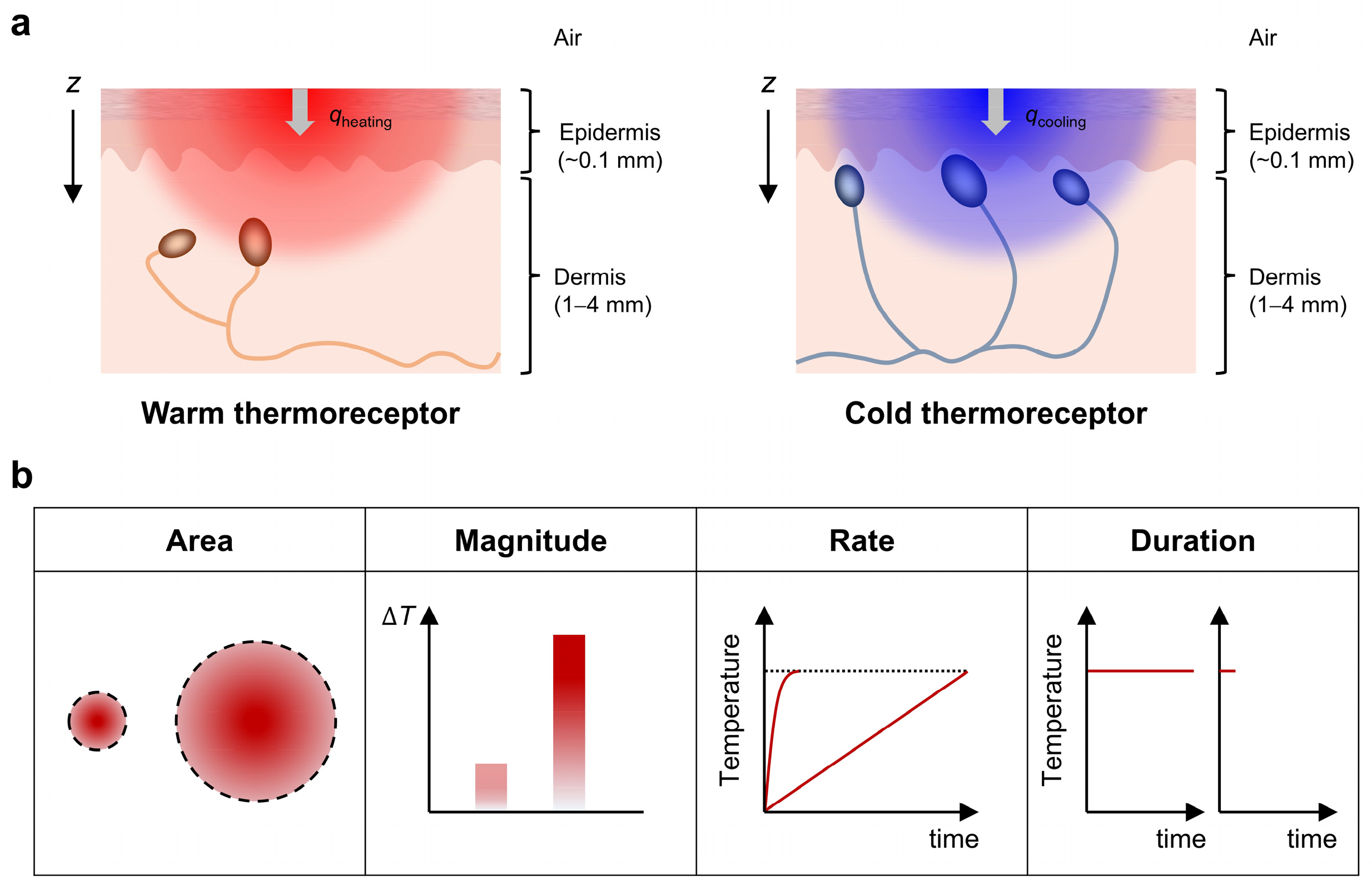
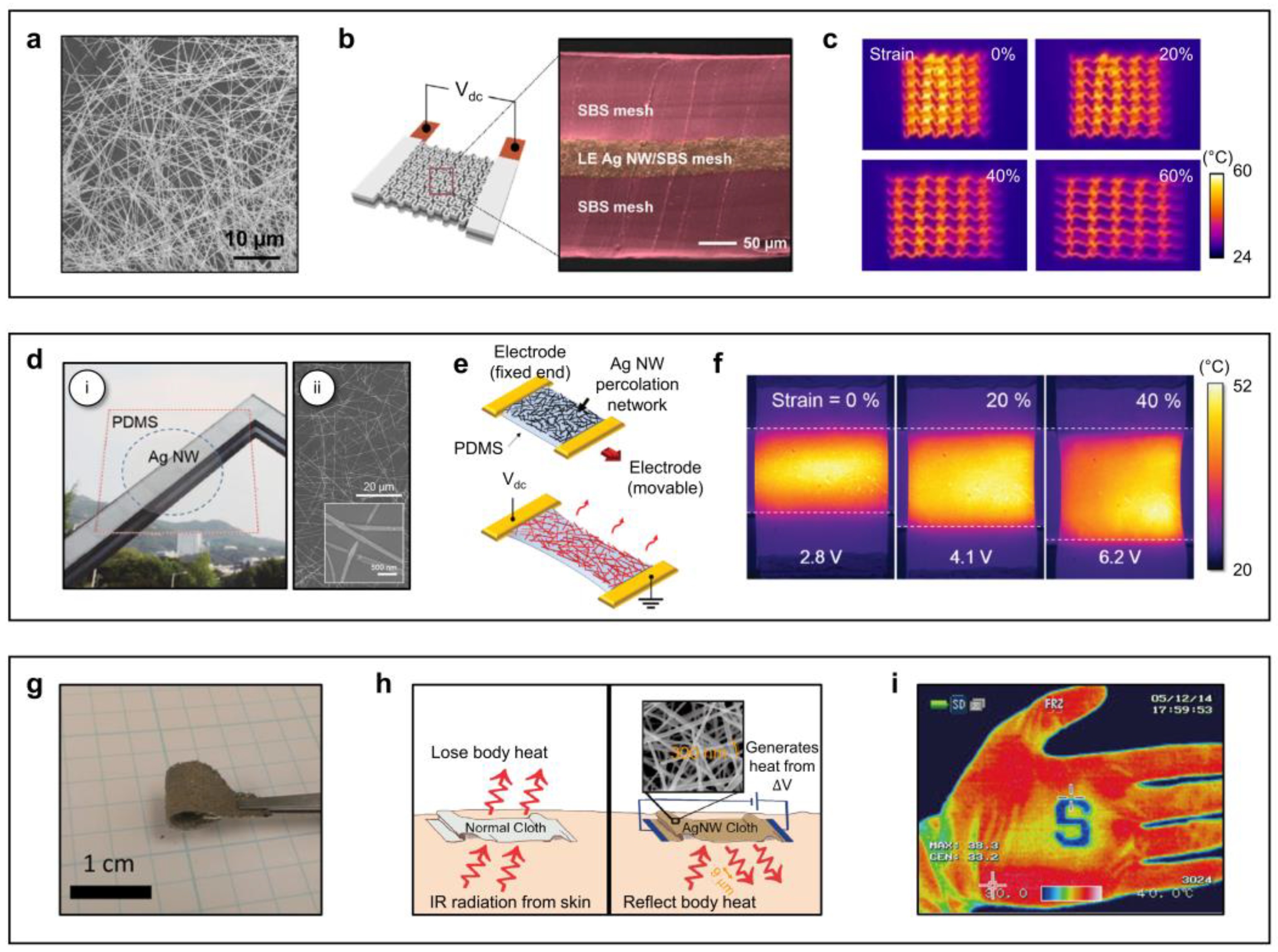


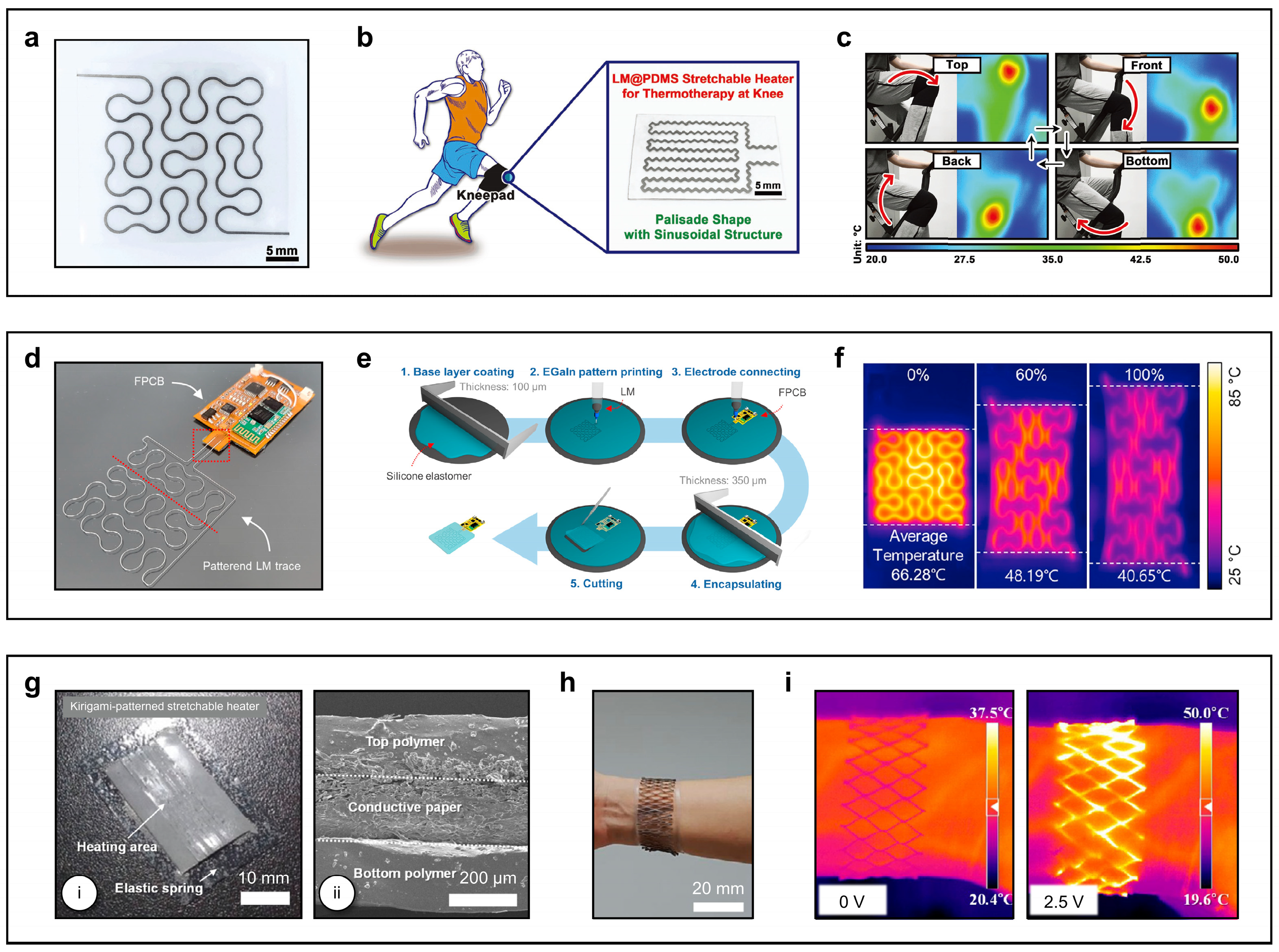
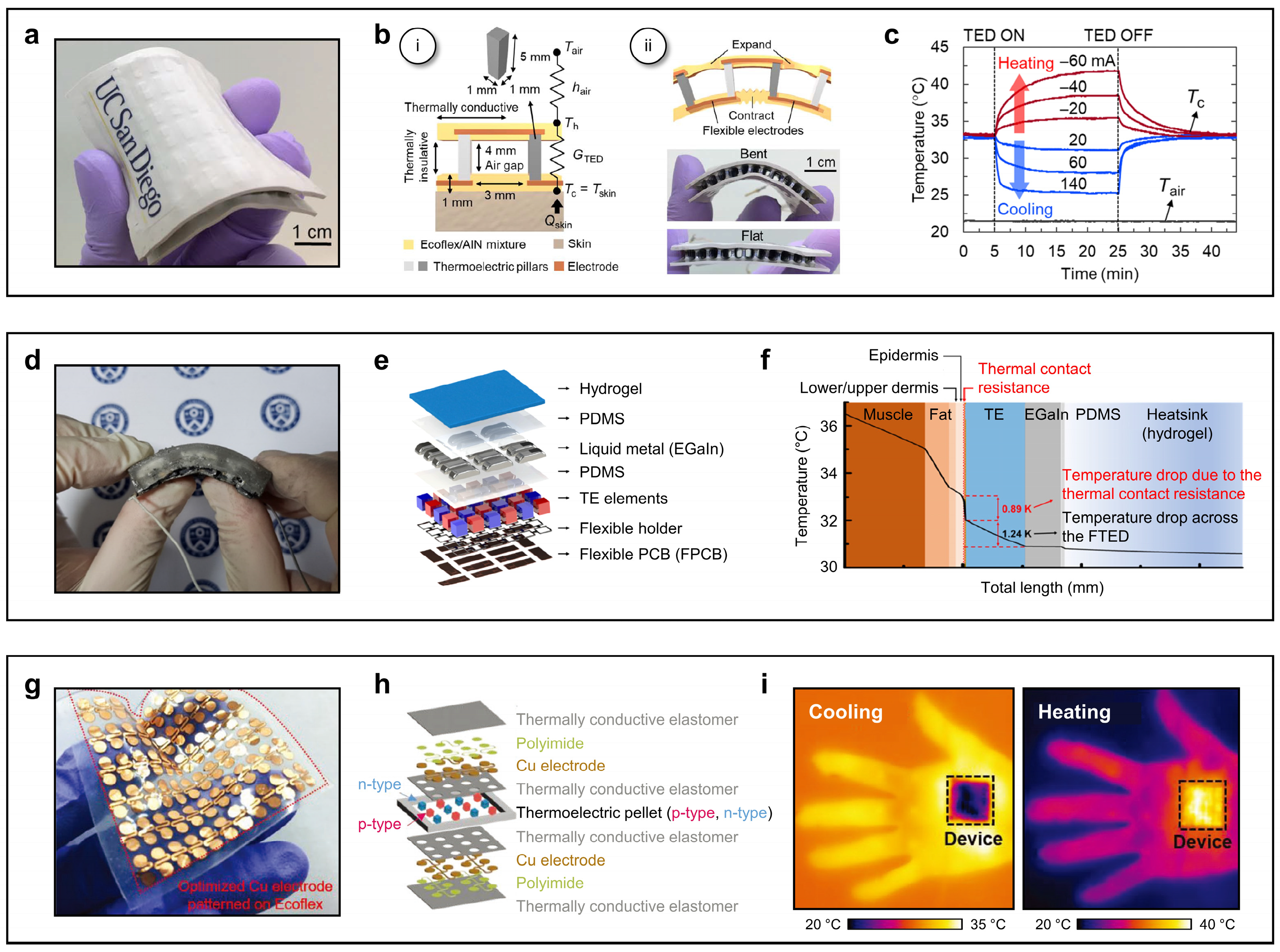
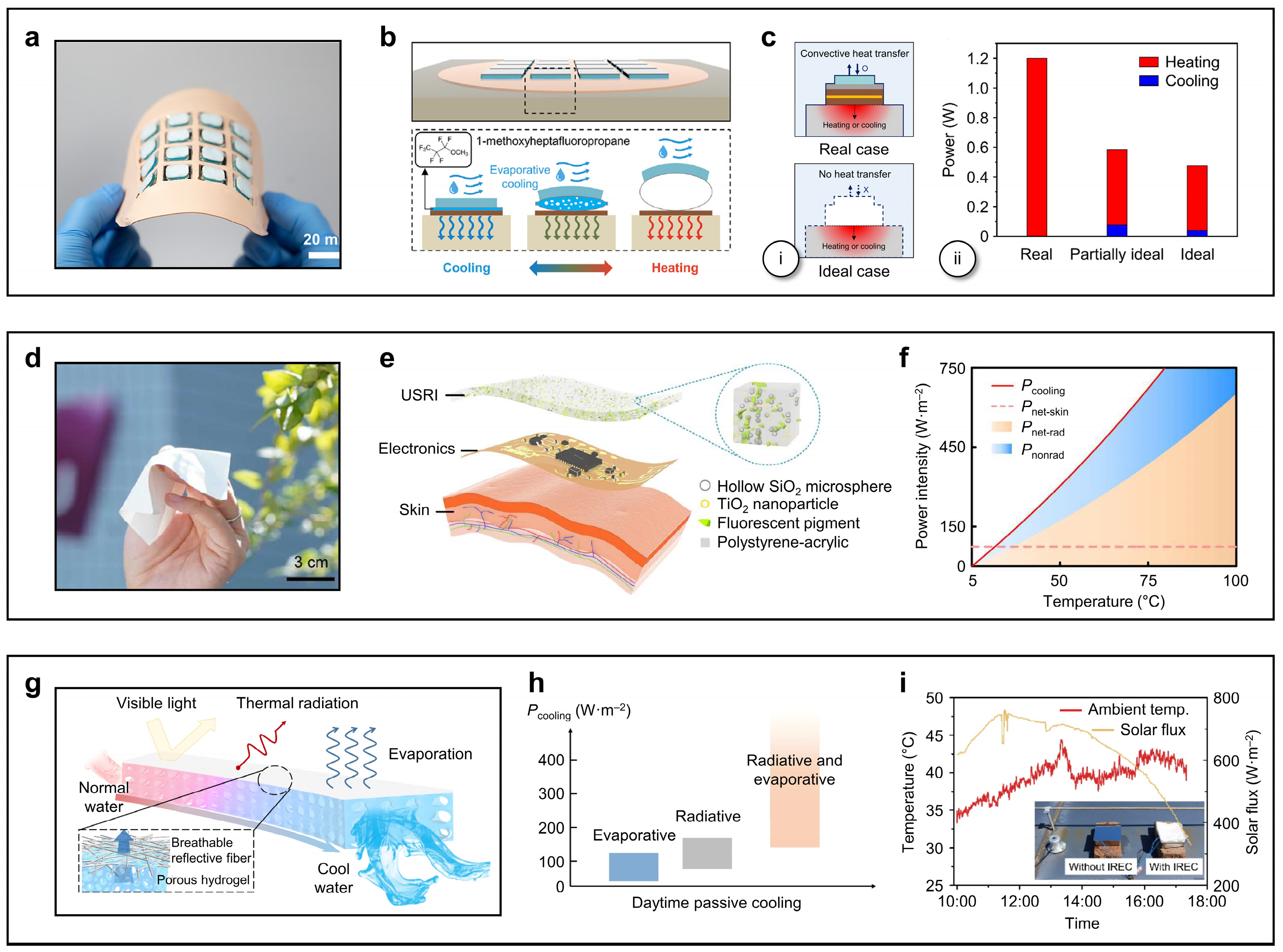
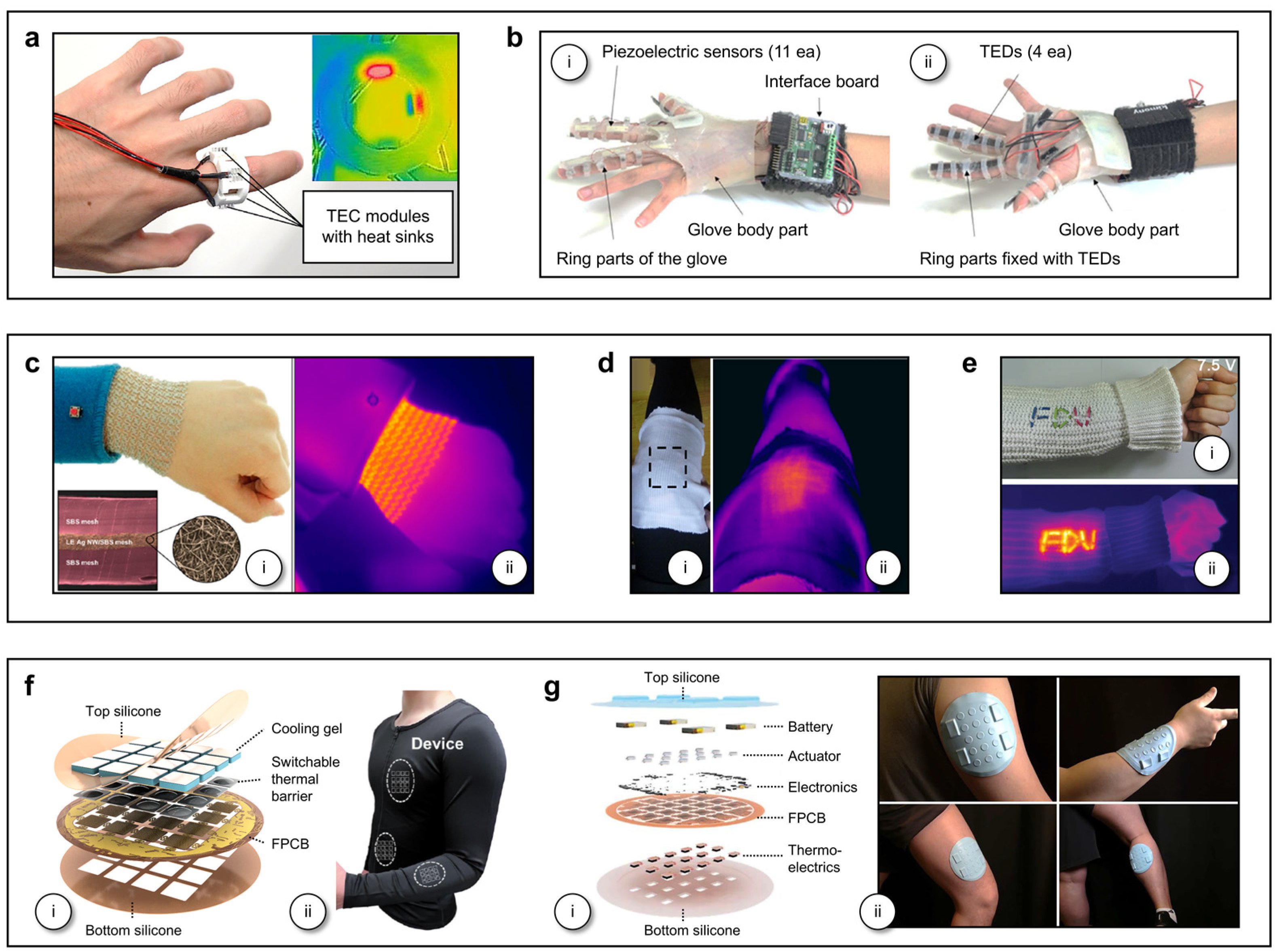


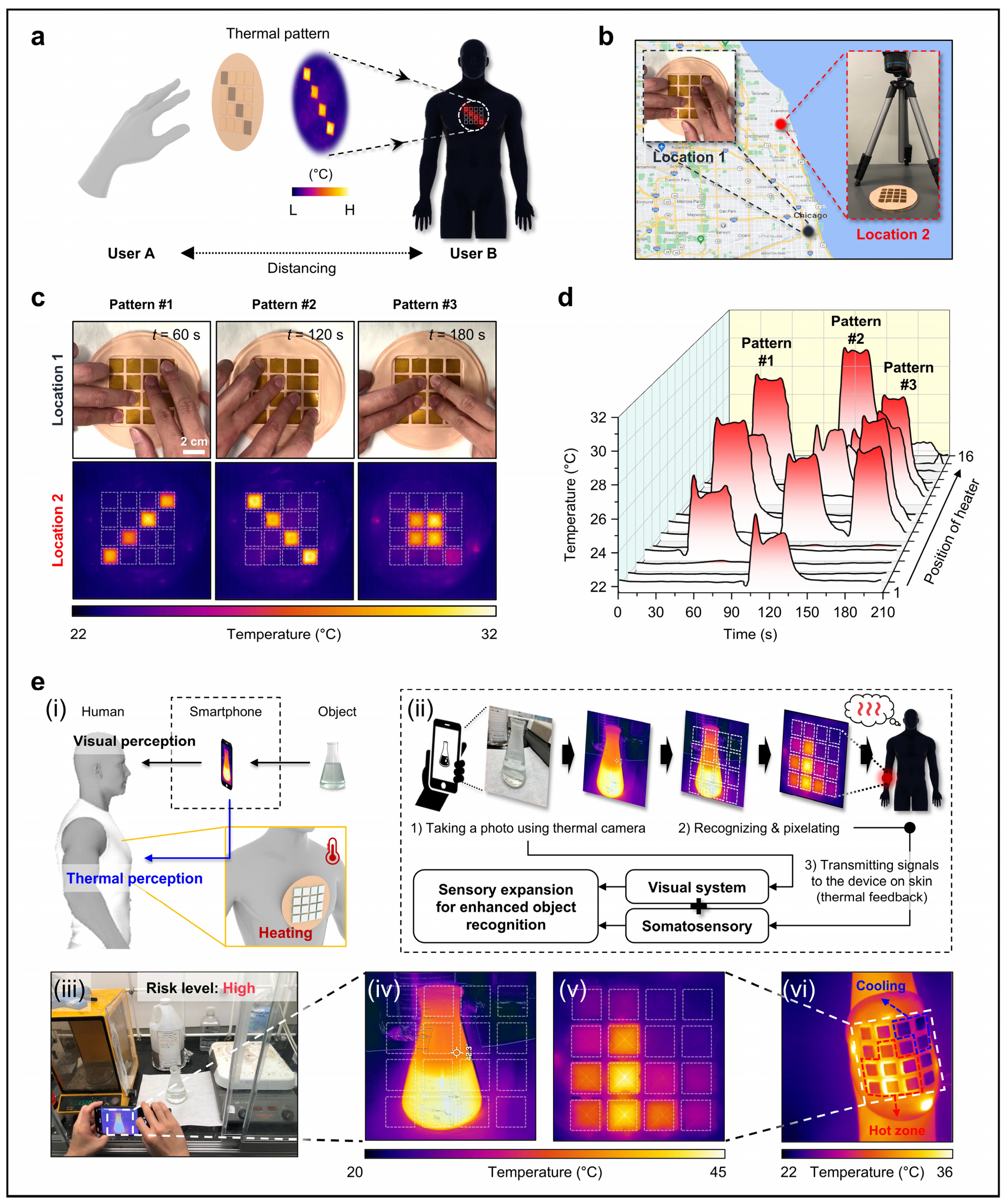
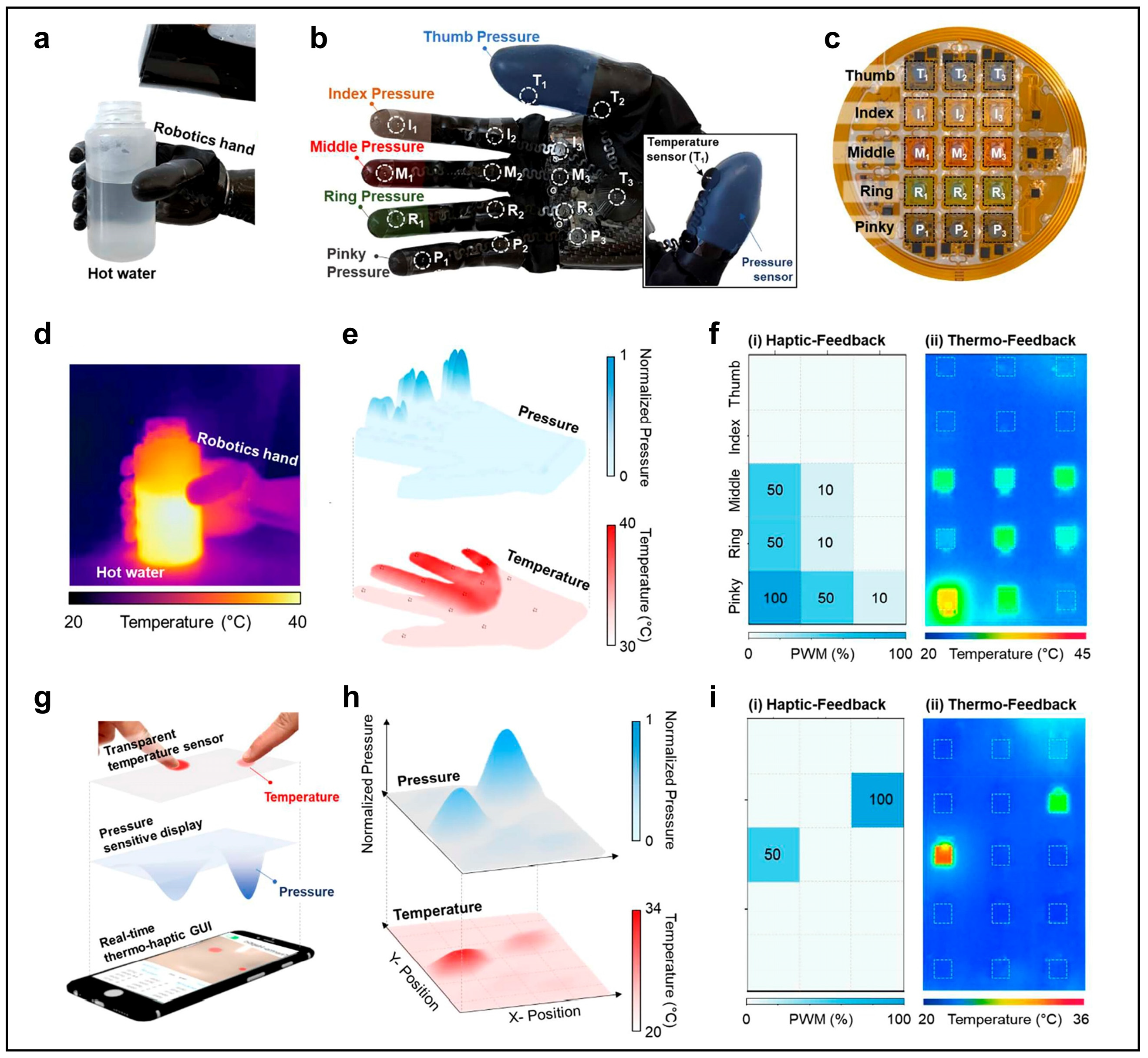
| Materials and Structure | Temperature Range | Electrical Input | Lateral Size and Form Factor | Ref. |
|---|---|---|---|---|
| CNT 1 and Ag NWs on PET 2 substrate | 25–110 °C | 5–15 V | 4 × 4 cm2 | [46] |
| Ligand exchanged Ag NWs in SBS 3 elastomer | 25–60 °C | 0.5–1.0 V | 4 × 4 cm2, stretchable (60%), wrist–wearable | [38] |
| CNT on Ecoflex | 25–268 °C | 10–50 V | 4.5 × 3.0 cm2, stretchable (400%) | [47] |
| Carbonized weft–knitted fabric | 20–140 °C | ~3.5 V | 4.5 × 4.5 cm2, stretchable (70%), knee–wearable | [48] |
| Kirigami–patterned Al paper on Ecoflex | 22–43 °C | 0.3–1.5 V | 14.5 × 12 cm2, stretchable (400%), wrist–wearable | [49] |
| PEDOT 4 coated on the fabrics | 21–44 °C | 3–6 V | 1 × 1 cm2, integrated with a glove | [50] |
| Ag NW–cloth, CNT–cloth | 21–55 °C | 0.6–1.2 V (Ag NW–cloth) 8–16 V (CNT–cloth) | 1 × 1 in. 2, integrated with a glove | [51] |
| Ag NW in PDMS 5 film | 20–150 °C | 2–10 V | Stretchable (60%), wrist–wearable | [52] |
| Liquid metal in PDMS film | 25–95 °C | 0.5–3.5 V | ~3 × 3 cm2, stretchable (>100%), kneepad | [53] |
| Ag NW with PEDOT:PSS 6 | 20–110 °C | 3–6 V | 5 × 6 cm2 | [54] |
| Ag NW with rGO 7 | 68–230 °C | 5–15 V | N/A * | [55] |
| Cu–Ni NW in PET film | 20–106 °C | 3–15 V | 4 × 2 cm2 | [56] |
| Ag NW–Clay on PET film | 40–110 °C | 3–7 V | 25 × 20 cm2 | [57] |
| Cu NW in PUA 8 film | 20–120 °C | 1–7 V | 1 × 1 cm2, stretchable (>50%), integrated with a glove | [31] |
| GF 9–embroidered cotton fabric | 50–424 °C | 0.9–4.7 V | Stretchable (70%), wrist–wearable | [58] |
| Ni–EGaIn 10 electronic tattoo | 25–66 °C | 0.1–0.5 A | 4.5 × 7 cm2, integrated with a glove | [59] |
| CNT on thermochromic silicon elastomer | 45–95 °C | 4–8 V | 2 × 0.5 cm2, stretchable (100%) | [60] |
| CB/PU 11 printed textiles | 30–85 °C | 2.5–20 V | 4 × 3 cm2 | [61] |
| Cu NW/PE 12 yarn on fabric | 25–150 °C | 0.9–6 V | ~8 × 6 cm2, stretchable (40%), integrated with a cloth | [62] |
| CNT HHF 13 on textile | 38–60 °C | 5–9 V | 15 × 7 cm2, stretchable (140%), integrated with a textile | [63] |
| EGaIn sandwiched in silicone | 25–89 °C | 1–6 V | 6 × 7 cm2, stretchable (100%) | [64] |
| Materials and Structure | Temperature Range | Electrical Input | Lateral Size and Form Factor | Ref. |
|---|---|---|---|---|
| Bi2Te3 based TE device with Ecoflex/Ag flake composite | ~15–35 °C | ~0.2–1.5 A | 2.7 × 2.7 cm2, 4 × 4 arrays, stretchable (230%), integrated with a glove | [29] |
| Bi2Te3 based TE device | ~22–35 °C | ~1–2.4 A | 1.6 × 1.6 cm2, 6 × 6 arrays | [115] |
| Bi2Te3 based TE device with AIN Ecoflex/AIN powder composite | ~25–42 °C (from skin temperature) | ~−60–140 mA | 5 × 5 cm2, 12 × 12 arrays, flexible (BR 1 ~40 mm), integrated with an armband | [30] |
| BST based TE devices (Bi0.5Sb1.5Te3 for p–type and Bi2Te2.7Se0.3 for n–type) with EGaIn/PDMS | ~5.4 K (human body cooling) | N/A * | 4.25 × 3.5 cm2, 6 × 5 arrays, flexible (BR ~29.35 mm) | [116] |
| Bi2Te3 based TE device with Ag flake/EGaIn/Ecoflex composite, thermochromic liquid crystal coating | ~3–40 °C | ~1.5–0.6 A | 9 × 5 arrays, flexible (BR ~2 cm) | [117] |
| Bi2Te3 based TE device | ~30–33 °C | N/A | Ring cases (6–11 US sizes), 4 or 6 or 8 TE devices | [21] |
| Bi2Te3 based TE device | N/A | N/A | Wrist band (67 × 42 × 27 mm3), 2 TE devices | [22] |
| Bi2Te3 based TE device with airbags | 28–40 °C | N/A | 2 TE devices (40 × 40 mm2) in each hot and cold chamber, integrated with a pneumatic glove | [27] |
| Bi2Te3 based TE device | N/A | N/A | Earhook cases, 3 or 4 or 5 TE devices | [28] |
| Bi2Te3 based TE device with Ecoflex | 15–40 °C | 0.67 A | 75 × 5 mm2 (middle finger), flexible (BR ~20 mm), integrated with a display glove | [26] |
Disclaimer/Publisher’s Note: The statements, opinions and data contained in all publications are solely those of the individual author(s) and contributor(s) and not of MDPI and/or the editor(s). MDPI and/or the editor(s) disclaim responsibility for any injury to people or property resulting from any ideas, methods, instructions or products referred to in the content. |
© 2025 by the author. Licensee MDPI, Basel, Switzerland. This article is an open access article distributed under the terms and conditions of the Creative Commons Attribution (CC BY) license (https://creativecommons.org/licenses/by/4.0/).
Share and Cite
Park, M. Recent Advances in Wearable Thermal Devices for Virtual and Augmented Reality. Micromachines 2025, 16, 383. https://doi.org/10.3390/mi16040383
Park M. Recent Advances in Wearable Thermal Devices for Virtual and Augmented Reality. Micromachines. 2025; 16(4):383. https://doi.org/10.3390/mi16040383
Chicago/Turabian StylePark, Minsu. 2025. "Recent Advances in Wearable Thermal Devices for Virtual and Augmented Reality" Micromachines 16, no. 4: 383. https://doi.org/10.3390/mi16040383
APA StylePark, M. (2025). Recent Advances in Wearable Thermal Devices for Virtual and Augmented Reality. Micromachines, 16(4), 383. https://doi.org/10.3390/mi16040383






